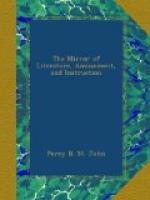In Aubrey’s time, A.D. 1663 73 stones In Dr. Stukeley’s time, A.D. 1722 29 — In 1815 17 —
Of very late years, says Sir Richard Colt Hoare, I do not imagine the dilapidations of the temple have been very great.
It should, however, be mentioned, that the tracing of the snake form is due to Dr. Stukeley; for his predecessor Aubrey mentions the avenue as “a solemn walk leading to a monument upon the top of the hill, without any allusion to the supposed design or its connexion with the Grand Temple at Abury.”
It is a matter of greater speculation than we can here enter into, as to the date and founders of Abury; and their history is as dislocated as are the masses of its ruins. Antiquarians agree on the purpose for which it was founded, viz. for the performance of the religious ceremonies of the Druids. Sir R. Colt Hoare illustrates this point by supposing the flat ledge projecting from the vallum, to have been intended for the accommodation of sitting, to the spectators who resorted hither to the public festivals; and adds he, what a grand and imposing spectacle must so extensive and elevated an amphitheatre have presented, the vallum and its declivities lined with spectators, whilst the hallowed area was preserved for the officiating Druids, and perhaps the higher order of the people!
Gentle Reader! be ye lordling or lowlier born, once more turn back to the engraving. We have a subject of yesterday rife and ready for you, on the next page; but turn to the engraving. Look again at those circles, and the fantastic forms that compose them, and think of the infatuated thousands that were wont to assemble round them, and of the idolized sons of power that once stood within their hallowed area. Think of those days of sacrifice and superstition—those orgies of ignorance and barbarism—and contrast them with the happy, happy age of religious liberty in which it is your boast and blessing to live—and then you may read “sermons in stones,” to the masterminds of your own time. To us, the stones of Abury are part of the poetry of savage life, and of more interest than all the plaster toys of these days. But they may not be so with you and “FINIS.” We were once compensated for missing Fonthill and its finery, by witnessing day-break from Salisbury Plain, and associating its glories with the time-worn relics of STONEHENGE!
The engraving and data are from Mr. Higgins’s Celtic Druids, for the loan of which and a portion of this article, we thank our friend “JAMES SILVESTER,” whose valuable note on “Circular Temples” must stand over for our next.
* * * * *
We had penciled for our Supplement the following beautiful lines from Mr. Watts’s “Literary Souvenir,” but they will be more in place here. Silbury is an immense mound adjoining the road to Devizes, and opposite Abury; Sir R.C. Hoare thinks it part of Abury; but H. and many others think it the sepulchre of a King or Arch-Druid.




